Do Historic Landscape Images Predict Tourists’ Spatio-Temporal Behavior at Heritage Sites? A Case Study of West Lake in Hangzhou, China
Abstract
1. Introduction
1.1. Destination Images
1.2. Tourists’ Spatio-Temporal Behaviors
1.3. Big Data GPS Technology and Spatio-Temporal Behavior
- How are the HLIs of heritage sites perceived?
- How do HLIs explain visitors’ spatio-temporal behaviors?
- What are the implications of HLIs for the future of heritage tourism management and urban development?
2. Materials and Methods
2.1. Study Area
2.2. Analytical Framework
2.3. Data Collection
2.3.1. Historic Landscape Images
2.3.2. Intra-Attraction Tourist Behaviors
2.4. Data Analysis
2.4.1. HLI Identification and Construction
2.4.2. Construction of IATBs
2.4.3. Correlation and Regression Analysis
3. Results
3.1. HLIs and Word Frequency
3.2. Visitor Distribution
3.3. Correlations between IATBs and HLIs
3.3.1. Visitor Paths
3.3.2. Visitor Dwell Time
3.3.3. Average Visitor Dwell Time
3.3.4. Tour Speed
4. Discussion
4.1. Influence of HLIs on IATBs
4.2. HLIs Are an Influential Predictor of Future Tourism Trends for Heritage
4.3. Limitations and Future Research
5. Conclusions
Author Contributions
Funding
Institutional Review Board Statement
Informed Consent Statement
Data Availability Statement
Conflicts of Interest
Appendix A
| Serial Number | Scenic Areas | Scenic Area Number | Attractions Number | Attractions |
|---|---|---|---|---|
| [1] | Lakefront | A | A1 | Lingering Snow on Broken Bridge |
| [2] | A2 | Xiling Printing House | ||
| [3] | A3 | Sizhao Pavilion | ||
| [4] | A4 | Crane in Plum | ||
| [5] | A5 | Su Causeway in the Morning of Spring | ||
| [6] | A6 | Mid-Lake Pavilion | ||
| [7] | A7 | Orioles Singing in the Willows | ||
| [8] | A8 | Evening Bell Ringing at Nanping Hill | ||
| [9] | A9 | Leifeng Pagoda in Evening Glow | ||
| [10] | A10 | MAO’s Home Port | ||
| [11] | A11 | Viewing Fish at Flowery Pond | ||
| [12] | A12 | Breeze-ruffled Lotus at Winding Garden | ||
| [13] | A13 | Autumn Moon over the Calm Lake | ||
| [14] | A14 | Three Pools Mirroring the Moon | ||
| [15] | A15 | Twin Peaks Piercing the Cloud | ||
| [16] | North Hill | B | B1 | Zhiguo Temple |
| [17] | B2 | Manao Temple | ||
| [18] | B3 | Wanghu Building | ||
| [19] | B4 | Precious Stone Hill Floating in Rosy Cloud | ||
| [20] | B5 | Precious Stone Hill Statue | ||
| [21] | B6 | Baoyun Temple | ||
| [22] | B7 | Ge Ling Chao | ||
| [23] | B8 | Site of Zhaolan Temple | ||
| [24] | B9 | Purple Cloud Cave | ||
| [25] | B10 | Tomb of Niuhao | ||
| [26] | Tiger Spring and Longjing Well | C | C1 | Stone House Cave |
| [27] | C2 | Water Music Cave | ||
| [28] | C3 | Haze at Sunset Cave | ||
| [29] | C4 | Longjing Well with Tea | ||
| [30] | C5 | Eight Sights of Longjing Well | ||
| [31] | C6 | Tiger Spring | ||
| [32] | Qiantang River | D | D1 | Nine Creeks and Eighteen Gullies |
| [33] | D2 | Liuhe Pagoda | ||
| [34] | D3 | Nine Streams to Watch The Tide | ||
| [35] | Phoenix Hill | E | E1 | Ci Yunling Statues |
| [36] | E2 | Denon Temple | ||
| [37] | E3 | Tomb of Wuhanyue | ||
| [38] | E4 | Myriad Pines Academy | ||
| [39] | E5 | Southern Song Dynasty Imperial City Site | ||
| [40] | E6 | Fantian Temple Heritage Park | ||
| [41] | Botanical Garden | F | F1 | Zhangxian Tomb |
| [42] | F2 | Jade Spring | ||
| [43] | F3 | Appreciate Plum Blossoms in Lingfeng Hill | ||
| [44] | Lingzhu | G | G1 | Clock Sinking in Hejian River |
| [45] | G2 | Peak That Flew from Afar | ||
| [46] | G3 | Cold Spring Pavilion | ||
| [47] | G4 | North Peak | ||
| [48] | G5 | Lingyin Temple | ||
| [49] | G6 | Mengxie Pavilion | ||
| [50] | G7 | Cuiwei Pavilion | ||
| [51] | G8 | Yongfu Temple | ||
| [52] | G9 | Stone with Three Lifetimes | ||
| [53] | G10 | Fajing Temple | ||
| [54] | G11 | Faxi Temple | ||
| [55] | Color Clouds | H | H1 | Color Clouds Hill |
| [56] | Wu Mountain | I | I1 | Three-Thatched-Hut Temple |
| [57] | I2 | Clouds Living and Pine’s Sound | ||
| [58] | I3 | Chenghuang Temple | ||
| [59] | I4 | Qingyi Cave |
References
- Ezenagu, N. Heritage resources as a driver for cultural tourism in Nigeria. Cogent Arts Humanit. 2020, 7, 1734331. [Google Scholar] [CrossRef]
- Richards, G. Cultural tourism: A review of recent research and trends. J. Hosp. Tour. Manag. 2018, 36, 12–21. [Google Scholar] [CrossRef]
- Dudley, N. (Ed.) Guidelines for Applying Protected Area Management Categories; International Union for Conservation of Nature: Gland, Switzerland, 2008. [Google Scholar]
- Jimber del Rio, J.A.; Hernández-Rojas, R.D.; Vergara-Romero, A.; Dancausa Millán, M.G.D. Loyalty in heritage tourism: The case of Córdoba and its four world heritage sites. Int. J. Environ. Res. Public Health 2020, 17, 8950. [Google Scholar] [CrossRef] [PubMed]
- Lynch, K. The image of the environment. Image City 1960, 11, 1–13. [Google Scholar]
- Stylidis, D. Residents’ destination image: A perspective article. Tour. Rev. 2020, 75, 228–231. [Google Scholar] [CrossRef]
- Molinillo, S.; Liébana-Cabanillas, F.; Anaya-Sánchez, R.; Buhalis, D. DMO online platforms: Image and intention to visit. Tour. Manag. 2018, 65, 116–130. [Google Scholar] [CrossRef]
- Zhang, X.; Zhang, C.; Li, Y.; Xu, Z.; Huang, Z. Hierarchical Fusion Process of Destination Image Formation: Targeting on Urban Tourism Destination. Sustainability 2021, 13, 11805. [Google Scholar] [CrossRef]
- Lu, S.; Li, G.; Xu, M. The linguistic landscape in rural destinations: A case study of Hongcun Village in China. Tour. Manag. 2020, 77, 104005. [Google Scholar] [CrossRef]
- Marine-Roig, E.; Ferrer-Rosell, B. Measuring the gap between projected and perceived destination images of Catalonia using compositional analysis. Tour. Manag. 2018, 68, 236–249. [Google Scholar] [CrossRef]
- Liu, M.T.; Liu, Y.; Mo, Z.; Ng, K.L. Using text mining to track changes in travel destination image: The case of Macau. Asia Pacific J. Mark. Logist. 2021, 33, 371–393. [Google Scholar] [CrossRef]
- Sun, G. Symmetry analysis in analyzing cognitive and emotional attitudes for tourism consumers by applying artificial intelligence python technology. Symmetry 2020, 12, 606. [Google Scholar] [CrossRef]
- Edwards, D.; Griffin, T. Understanding tourists’ spatial behaviour: GPS tracking as an aid to sustainable destination management. J. Sustain. Tour. 2013, 21, 580–595. [Google Scholar] [CrossRef]
- Mckercher, B.; Lau, G. Movement patterns of tourists within a destination. Tour. Geogr. 2008, 10, 355–374. [Google Scholar] [CrossRef]
- Zoltan, J.; McKercher, B. Analysing intra-destination movements and activity participation of tourists through destination card consumption. Tour. Geogr. 2015, 17, 19–35. [Google Scholar] [CrossRef]
- Hall, C.M. Reconsidering the geography of tourism and contemporary mobility. Geogr. Res. 2005, 43, 125–139. [Google Scholar] [CrossRef]
- Lew, A.; McKercher, B. Modeling tourist movements: A local destination analysis. Ann. Tour. Res. 2006, 33, 403–423. [Google Scholar] [CrossRef]
- Zhao, X.; Lu, X.; Liu, Y.; Lin, J.; An, J. Tourist movement patterns understanding from the perspective of travel party size using mobile tracking data: A case study of Xi’an, China. Tour. Manag. 2018, 69, 368–383. [Google Scholar] [CrossRef]
- Xia, J.C.; Evans, F.H.; Spilsbury, K.; Ciesielski, V.; Arrowsmith, C.; Wright, G. Market segments based on the dominant movement patterns of tourists. Tour. Manag. 2010, 31, 464–469. [Google Scholar] [CrossRef]
- Casanueva, C.; Gallego, Á.; García-Sánchez, M.R. Social network analysis in tourism. Curr. Issues Tour. 2016, 19, 1190–1209. [Google Scholar] [CrossRef]
- Li, Y.; Xie, J.; Gao, X.; Law, A. A Method of selecting potential development regions based on GPS and social network models–from the perspective of tourist behavior. Asia Pac. J. Tour. Res. 2021, 26, 183–199. [Google Scholar] [CrossRef]
- Xiao-Ting, H.; Bi-Hu, W. Intra-attraction tourist spatial-temporal behaviour patterns. Tour. Geogr. 2012, 14, 625–645. [Google Scholar] [CrossRef]
- Li, Y.; Yang, L.; Shen, H.; Wu, Z. Modeling intra-destination travel behavior of tourists through spatio-temporal analysis. J. Destin. Mark. Manag. 2019, 11, 260–269. [Google Scholar] [CrossRef]
- Caldeira, A.M.; Kastenholz, E. Tourists’ spatial behaviour in urban destinations: The effect of prior destination experience. J. Vacat. Mark. 2018, 24, 247–260. [Google Scholar] [CrossRef]
- Afshardoost, M.; Eshaghi, M.S. Destination image and tourist behavioural intentions: A meta-analysis. Tour. Manag. 2020, 81, 104154. [Google Scholar] [CrossRef]
- Caldeira, A.M.; Kastenholz, E. Spatiotemporal tourist behaviour in urban destinations: A framework of analysis. Tour. Geogr. 2020, 22, 22–50. [Google Scholar] [CrossRef]
- Shoval, N.; Isaacson, M. Tracking tourists in the digital age. Ann. Tour. Res. 2007, 34, 141–159. [Google Scholar] [CrossRef]
- Bursa, B.; Mailer, M.; Axhausen, K.W. Intra-destination travel behavior of alpine tourists: A literature review on choice determinants and the survey work. Transportation 2022, 1–52. [Google Scholar] [CrossRef]
- De Cantis, S.; Ferrante, M.; Kahani, A.; Shoval, N. Cruise passengers’ behavior at the destination: Investigation using GPS technology. Tour. Manag. 2016, 52, 133–150. [Google Scholar] [CrossRef]
- Li, Y.; Wang, Q.; Wang, D. Precision and differential analysis by using GPS and recall diaries in the tourist’s behavior research: The case of Gulangyu. Tour. Trib. 2017, 32, 81–92. [Google Scholar]
- East, D.; Osborne, P.; Kemp, S.; Woodfine, T. Combining GPS & survey data improves understanding of visitor behaviour. Tour. Manag. 2017, 61, 307–320. [Google Scholar] [CrossRef]
- Li, Y.; Ye, Y.; Xiao, L.; Xu, W.; Law, A.; Wang, D. Classifying community space at a historic site through cognitive mapping and GPS tracking: The case of Gulangyu, China. Urban Des. Int. 2017, 22, 127–149. [Google Scholar] [CrossRef]
- Asakura, Y.; Iryo, T. Analysis of tourist behaviour based on the tracking data collected using a mobile communication instrument. Transp. Res. Part A Policy Pract. 2007, 41, 684–690. [Google Scholar] [CrossRef]
- Shoval, N. Tracking technologies and urban analysis. Cities 2008, 25, 21–28. [Google Scholar] [CrossRef]
- Sugimoto, K.; Ota, K.; Suzuki, S. Visitor mobility and spatial structure in a local urban tourism destination: GPS tracking and network analysis. Sustainability 2019, 11, 919. [Google Scholar] [CrossRef]
- Yao, Q.; Shi, Y.; Li, H.; Wen, J.; Xi, J.; Wang, Q. Understanding the tourists’ Spatio-Temporal behavior using open GPS trajectory data: A case study of yuanmingyuan park (Beijing, China). Sustainability 2020, 13, 94. [Google Scholar] [CrossRef]
- Huang, X.; Li, M.; Zhang, J.; Zhang, L.; Zhang, H.; Yan, S. Tourists’ spatial-temporal behavior patterns in theme parks: A case study of Ocean Park Hong Kong. J. Destin. Mark. Manag. 2020, 15, 100411. [Google Scholar] [CrossRef]
- Li, X. Destination Image Perception of Tourists to Guangzhou—Based on Content Analysis of Online Travels. J. Serv. Sci. Manag. 2015, 8, 662. [Google Scholar] [CrossRef][Green Version]
- Glaser, B.G.; Strauss A., L. The Discovery of Grounded Theory; Alsine de Gruyter: New York, NY, USA, 1967. [Google Scholar]
- Bauer, J.R.; Rose, K. Variable grid method: An intuitive approach for simultaneously quantifying and visualizing spatial data and uncertainty. Trans. GIS 2015, 19, 377–397. [Google Scholar] [CrossRef]
- Grinberger, A.Y.; Shoval, N.; McKercher, B. Typologies of tourists’ time–space consumption: A new approach using GPS data and GIS tools. Tour. Geogr. 2014, 16, 105–123. [Google Scholar] [CrossRef]
- Olin, L. Form, meaning, and expression in landscape architecture. Landsc. J. 1988, 7, 149–168. [Google Scholar] [CrossRef]
- Asnawi, A. Destination images: Antecedents of city marketing, tourism event, and social media marketing concept. J. Perspekt. Pembiayaan Dan Pembang. Drh. 2021, 9, 171–186. [Google Scholar] [CrossRef]
- Wang, C.; Qu, H.; Hsu, M.K. Toward an integrated model of tourist expectation formation and gender difference. Tour. Manag. 2016, 54, 58–71. [Google Scholar] [CrossRef]
- Nguyen, T.T.T.; Tong, S. The impact of user-generated content on intention to select a travel destination. J. Mark. Anal. 2022, 1–15. [Google Scholar] [CrossRef]
- Xu, H.; Cheung, L.T.; Lovett, J.; Duan, X.; Pei, Q.; Liang, D. Understanding the influence of user-generated content on tourist loyalty behavior in a cultural World Heritage Site. Tour. Recreat. Res. 2021, 1–15. [Google Scholar] [CrossRef]
- Reif, J.; Schmücker, D. Exploring new ways of visitor tracking using big data sources: Opportunities and limits of passive mobile data for tourism. J. Destin. Mark. Manag. 2020, 18, 100481. [Google Scholar] [CrossRef]
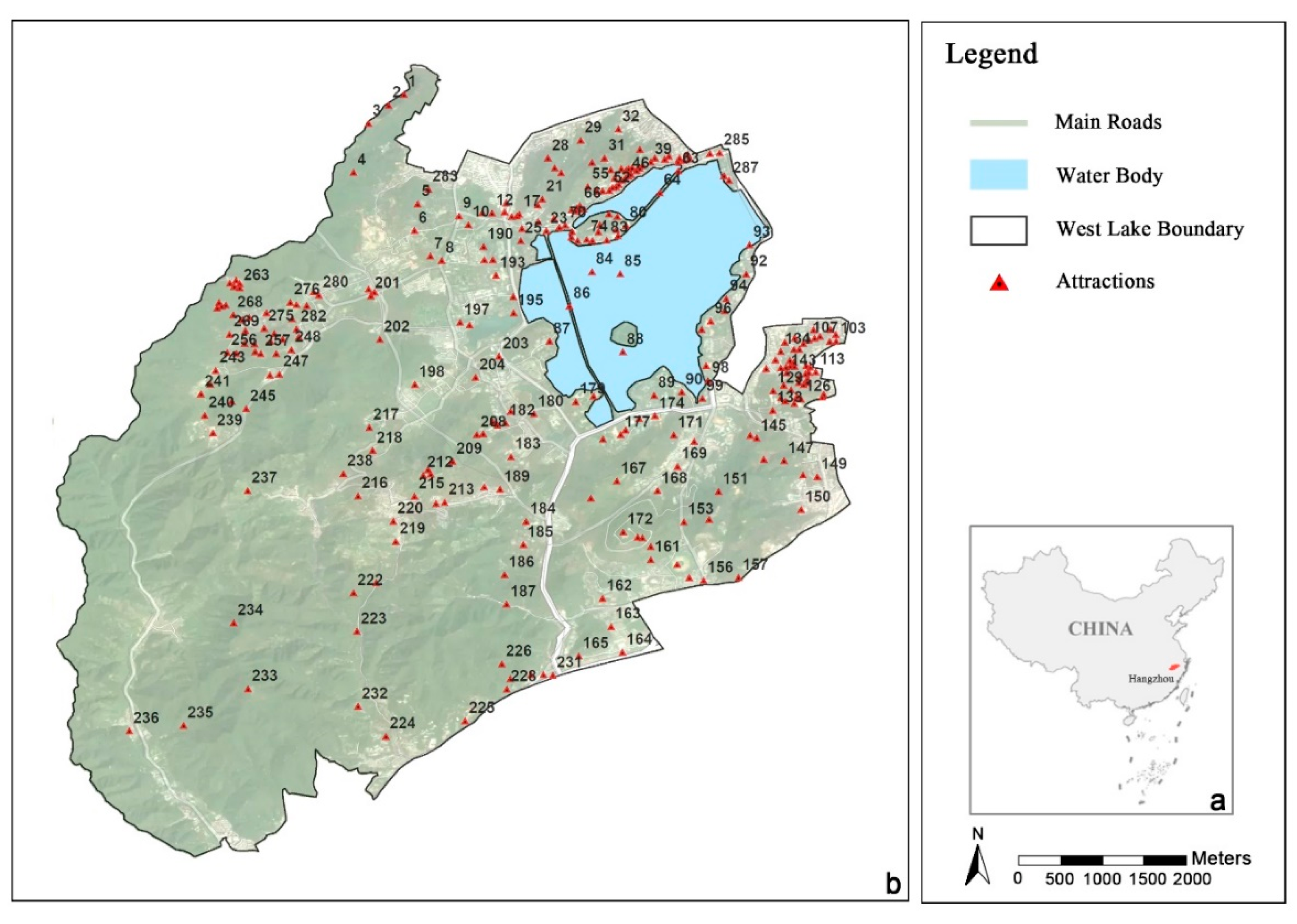


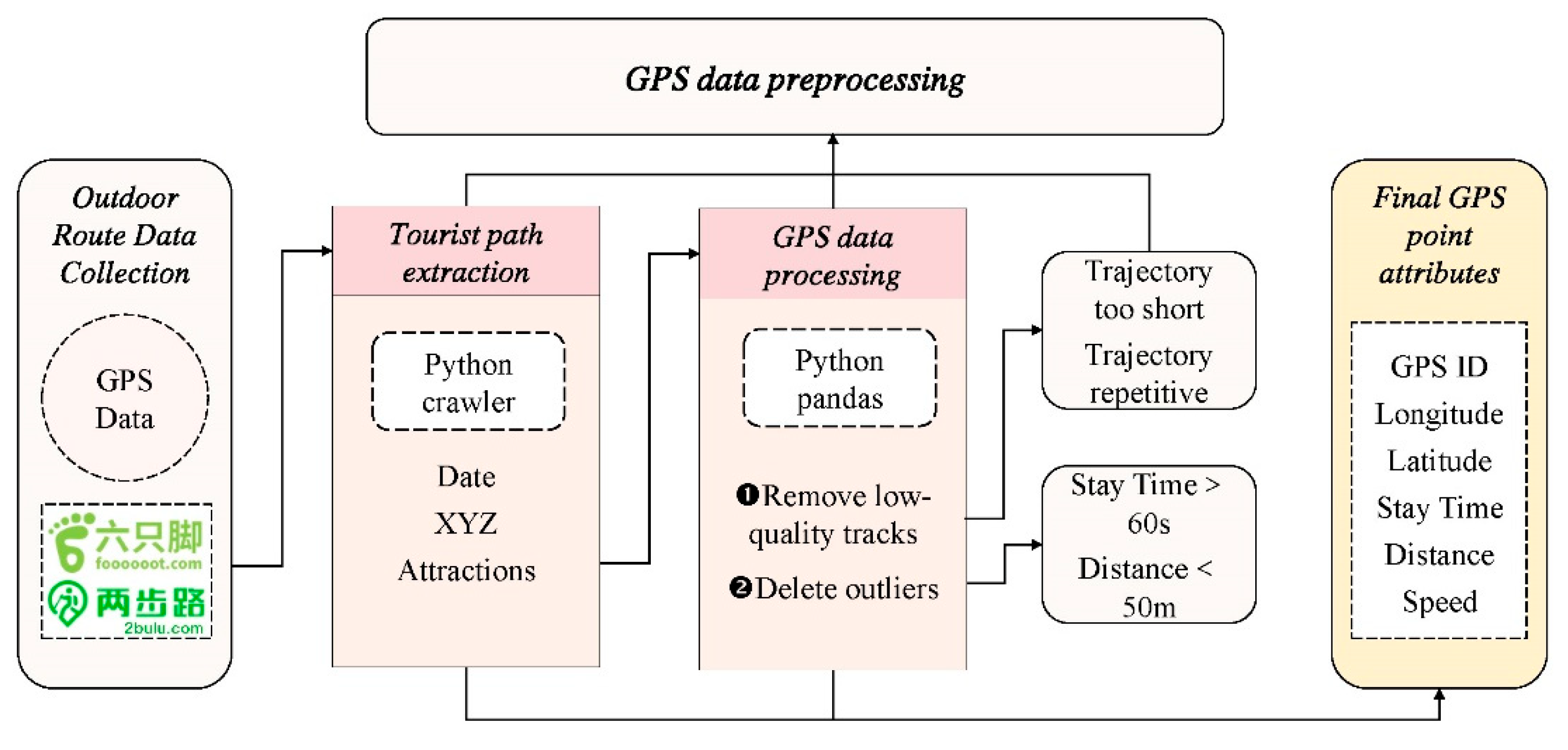


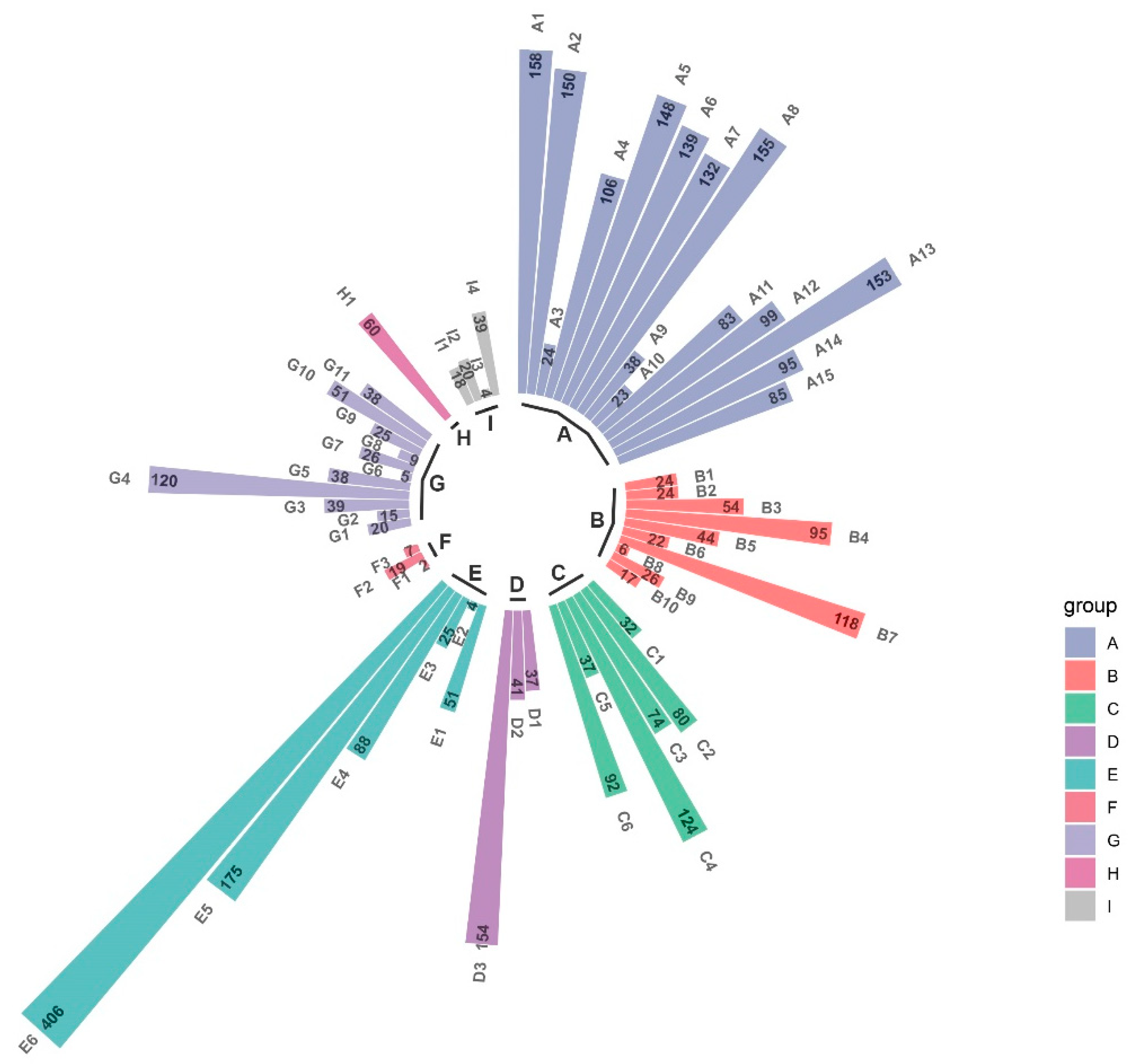

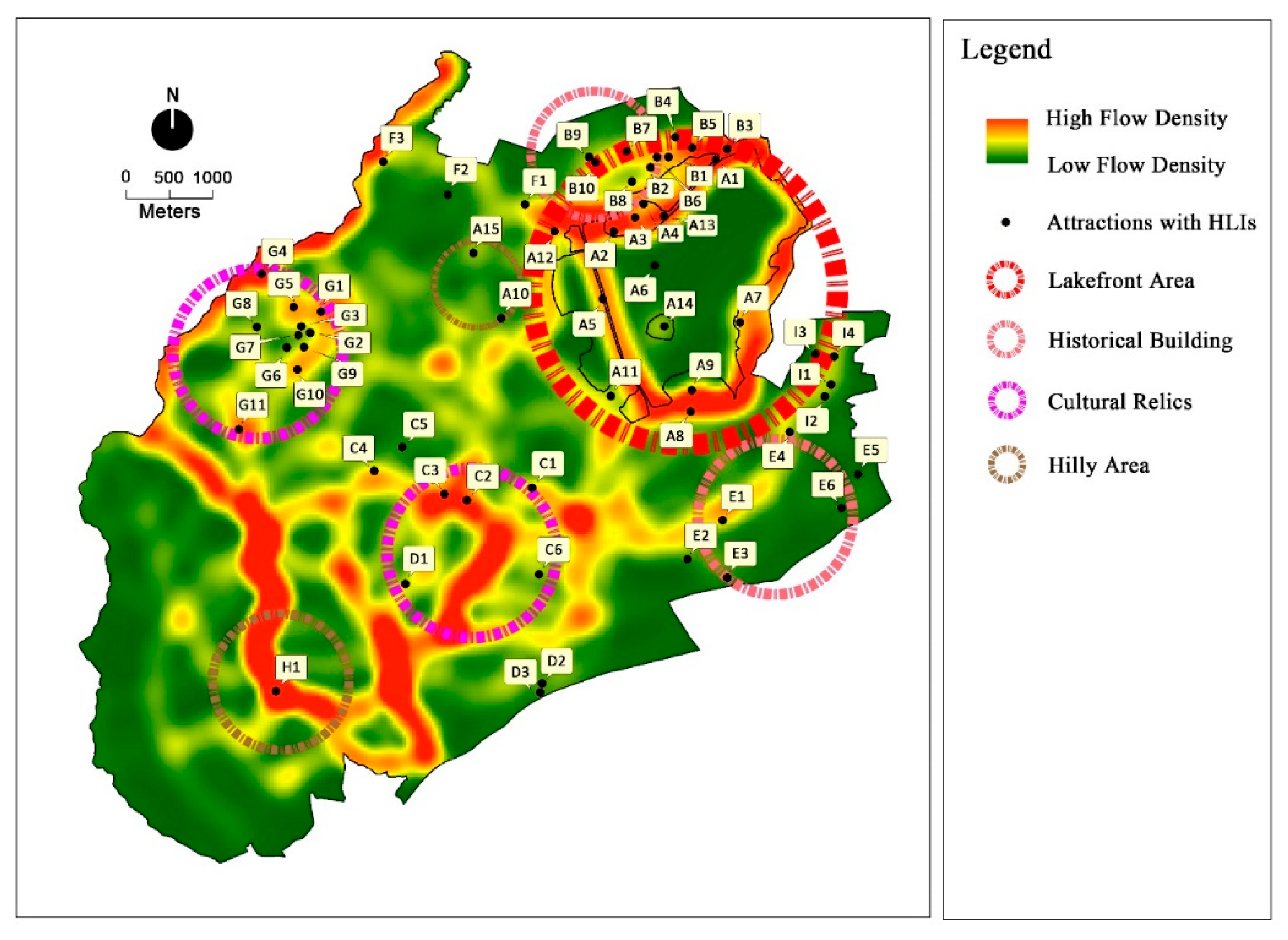

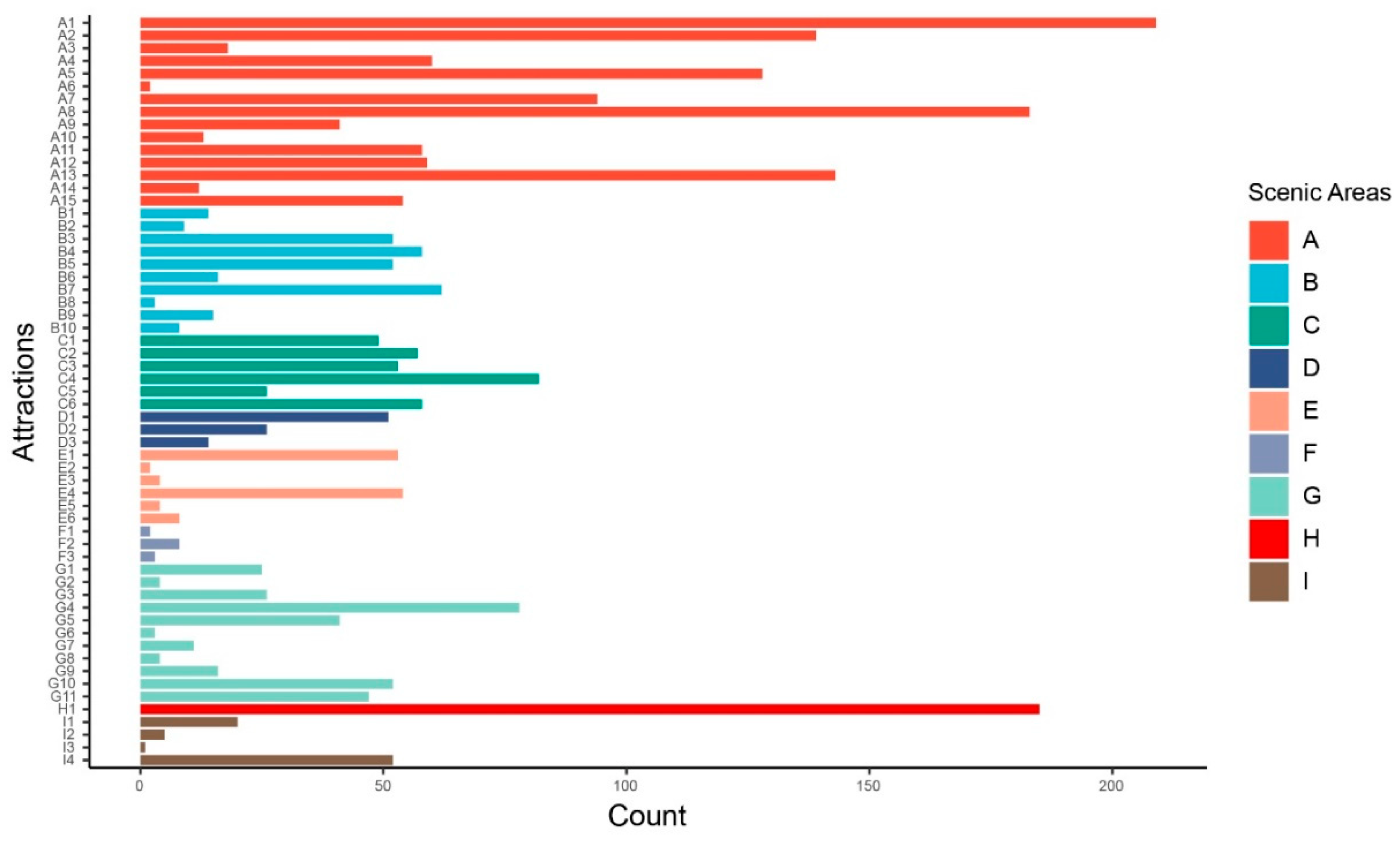
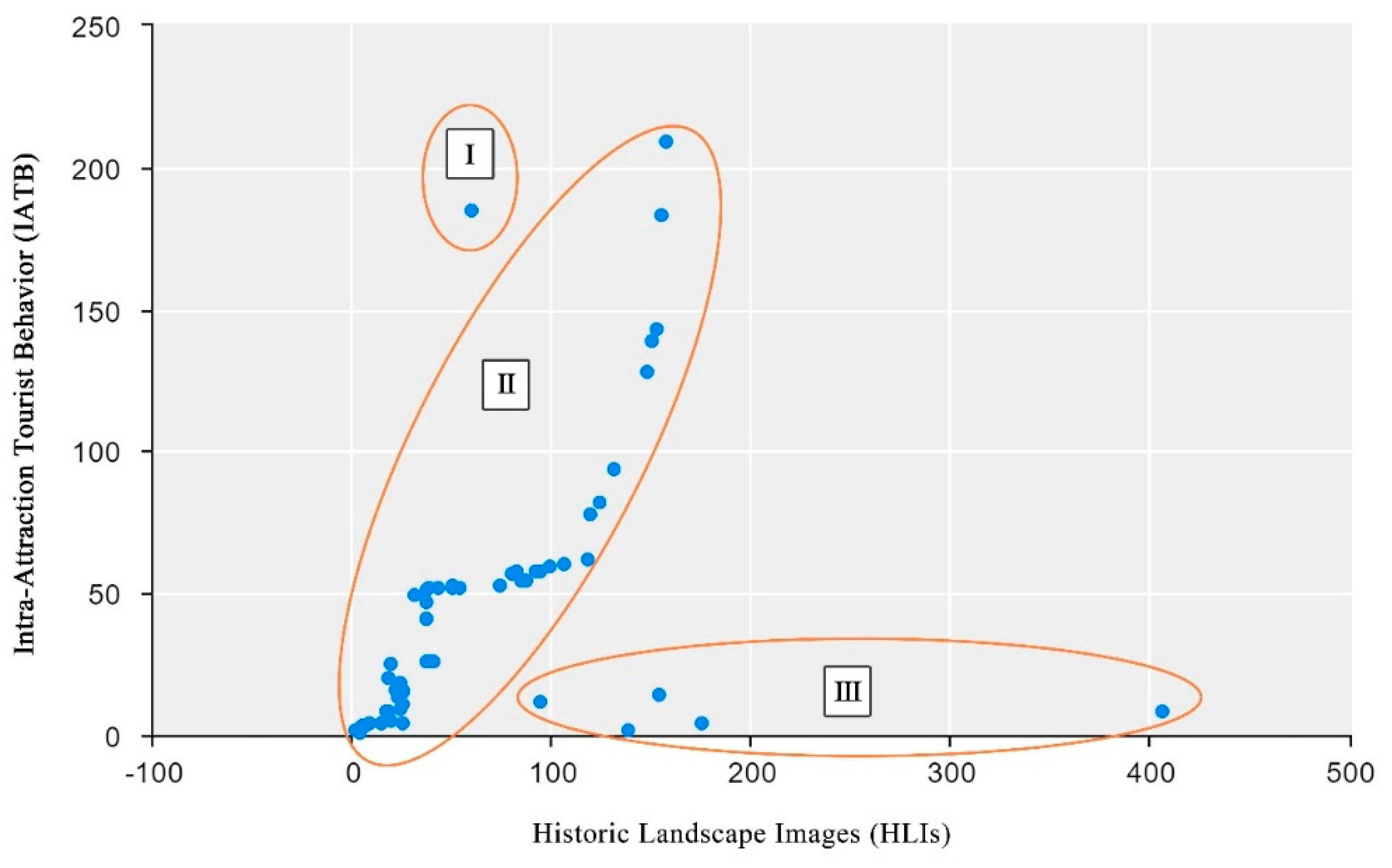
| Number | N | Longitude | Latitude | Dwell Time | Distance/m | Speed/m/s |
|---|---|---|---|---|---|---|
| 0 | 1 | 117.987288 | 30.004529 | 0 | 0.000 | 0.000 |
| 1 | 1 | 117.987170 | 30.004541 | 12 | 13.136 | 1.095 |
| 2 | 1 | 117.987063 | 30.004610 | 10 | 12.431 | 1.243 |
| 4 | 1 | 117.986925 | 30.004704 | 4 | 3.205 | 0.801 |
| 5 | 1 | 117.986848 | 30.004662 | 18 | 8.838 | 0.491 |
| … | … | … | … | … | … | … |
| 241 | 99 | 117.982672 | 30.004618 | 8 | 6.359 | 0.795 |
| 242 | 99 | 117.982701 | 30.004514 | 8 | 6.312 | 0.789 |
| 243 | 99 | 117.982709 | 30.004416 | 14 | 5.190 | 0.371 |
| 244 | 99 | 117.982752 | 30.004322 | 8 | 6.849 | 0.856 |
| 245 | 99 | 117.982786 | 30.004228 | 10 | 6.192 | 0.619 |
| Attractions | Original Materials | Source | Code | Initial Category |
|---|---|---|---|---|
| Lingering Snow on Broken Bridge (A1) | The bridge embankment is lush with smoke and willows, and the dewy grass looks like a skirt. (桥堤烟柳葱菁,露草芊绵,望如裙带) | (Ming Dynasty) West Lake Excursions | Bridge, Smoke, Willow, Grass (桥堤,烟,柳,草) | Infrastructure, Smoke, Plants, Vegetation |
| Xiling Printing House (A2) | The mountain is always moist without rain, and the water is clouds free. (不雨山常润,无云水自阴) | (Ming Dynasty) West Lake Excursions | Rain, Mountain, Clouds, Water (雨,山,云,水) | Rain, Mountain, Clouds, Lake |
| Three Pools Mirroring the Moon (A14) | The stars are sinking into the river, and the pipes and strings are shining across the river. (入河渐欲沉星斗,隔浦同看照管弦) | (Qing Dynasty) Selected Poems of West Lake | River, Stars, Orchestra (河,星斗,管弦) | Rivers, Stars, Feast |
| Twin Peaks Piercing the Cloud (A15) | The high peaks are listed on the distant mountains, and the pavilions have been there for hundreds of years. (高峰列远岑,亭亭几百载) | (Qing Dynasty) Selected Poems of West Lake | Peak, Pavilion (峰,亭) | Peaks, Buildings |
| Initial Category | Frequency | Initial Category | Frequency | Initial Category | Frequency | Initial Category | Frequency |
|---|---|---|---|---|---|---|---|
| Plant | 431 | Peak | 78 | Snow | 30 | Music | 14 |
| Building | 271 | Religion | 67 | Shadow | 30 | Stars | 13 |
| Lake | 235 | River | 65 | Fragrance | 29 | Residence | 12 |
| Mountain | 230 | Boat | 65 | Celebrity | 27 | City | 11 |
| Feast | 203 | Sound | 64 | Dream | 26 | Grave | 11 |
| Fowl | 175 | Spring | 63 | Country | 24 | Farmland | 11 |
| Infrastructure | 167 | Visitor | 60 | Fame | 20 | Valley | 11 |
| Cloud | 158 | Smog | 59 | Wonderland | 19 | Stream | 10 |
| Wind | 145 | Autumn | 58 | Emotion | 17 | Tour | 10 |
| Myth | 144 | Beast | 54 | Fog | 17 | Village | 9 |
| Goods | 123 | Sun | 58 | Palace | 15 | Seclusion | 9 |
| Moon | 101 | Spring | 53 | Cave | 15 | Summer | 8 |
| Rock | 96 | Sea | 49 | Wells | 14 | Food | 8 |
| Waves | 93 | Sky | 47 | Road | 14 | Fire | 6 |
| Rain | 82 | Forest | 40 | Island | 14 | War | 5 |
| Number | Main Category | Initial Category |
|---|---|---|
| 1 | Mountain Resources | Mountain, Peak, Valley, Cave |
| 2 | Biological Resources | Forest, Plant, Fowl, Beast |
| 3 | Meteorological Resources | Wind, Smog, Rain, Cloud, Fog, Snow |
| 4 | Astronomical Resources | Sky, Sun, Moon, Stars, Shadow |
| 5 | Water Resources | Lake, Sea, River, Spring, Waves, Stream, Island |
| 6 | Seasonality | Spring, Summer, Autumn |
| 7 | Myth and Legend | Myth, Wonderland |
| 8 | Traditional Chinese Culture | Celebrity, Religion, Custom, Seclusion |
| 9 | Emotional Expression | Emotion |
| 10 | Imagination Association | Dream |
| 11 | Traditional Architecture | Building, Residence, Palace |
| 12 | Infrastructure | Infrastructure, Road |
| 13 | Sightseeing | Feast, Visitor, Tour |
| 14 | Auditory Landscape | Sound, Music |
| 15 | Production and Living | Boat, Goods, Food, Fire, Farmland, City, Grave, Village, Wells |
| 16 | Political Factors | Country, War, Fame |
| 17 | Olfactory Landscape | Fragrance |
| Core Category | Main Category | Frequency |
|---|---|---|
| Natural Resources | Mountain Resources, Biological Resources, Meteorological Resources, Astronomical Resources, Water Resources, Seasonality | 2518 |
| Building Facilities | Traditional Architecture, Infrastructure | 479 |
| Behavioral Interaction | Sightseeing, Production and Living, Political Factors | 580 |
| Cultural Characteristics | Myth and Legend, Traditional Chinese Culture | 266 |
| Aesthetic Activity | Emotional Expression, Imagination Association, Auditory Landscape, Olfactory Landscape | 150 |
Publisher’s Note: MDPI stays neutral with regard to jurisdictional claims in published maps and institutional affiliations. |
© 2022 by the authors. Licensee MDPI, Basel, Switzerland. This article is an open access article distributed under the terms and conditions of the Creative Commons Attribution (CC BY) license (https://creativecommons.org/licenses/by/4.0/).
Share and Cite
Liu, Q.; Tang, X.; Li, K. Do Historic Landscape Images Predict Tourists’ Spatio-Temporal Behavior at Heritage Sites? A Case Study of West Lake in Hangzhou, China. Land 2022, 11, 1643. https://doi.org/10.3390/land11101643
Liu Q, Tang X, Li K. Do Historic Landscape Images Predict Tourists’ Spatio-Temporal Behavior at Heritage Sites? A Case Study of West Lake in Hangzhou, China. Land. 2022; 11(10):1643. https://doi.org/10.3390/land11101643
Chicago/Turabian StyleLiu, Qiqi, Xiaolan Tang, and Ka Li. 2022. "Do Historic Landscape Images Predict Tourists’ Spatio-Temporal Behavior at Heritage Sites? A Case Study of West Lake in Hangzhou, China" Land 11, no. 10: 1643. https://doi.org/10.3390/land11101643
APA StyleLiu, Q., Tang, X., & Li, K. (2022). Do Historic Landscape Images Predict Tourists’ Spatio-Temporal Behavior at Heritage Sites? A Case Study of West Lake in Hangzhou, China. Land, 11(10), 1643. https://doi.org/10.3390/land11101643





